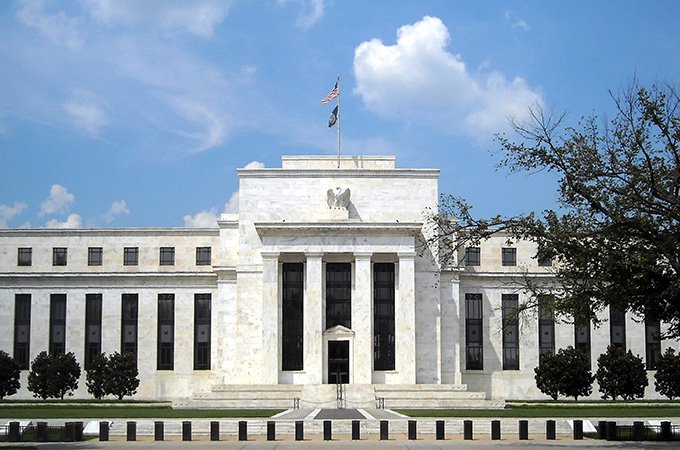
The “Wal-Mart Moment” for Banks
By Gaurav Sharma
Market shifts are a bit like earthquakes. A lot of pressure builds up over a long period of time. There are small tremors, but for the most part, nobody notices any change. The tectonic plates may actually have risen or fallen a few feet, but it is not noticeable on the surface due to small changes over a long time. But then, suddenly things pop and the world is quickly thrown into a primal state of Darwinian survival. Only the most adaptable— survive to see the world renewed.
Today, we operate in a market where innovation and progress requires disrupting the rules of the old world. Do you remember what it was like to hail a cab? Me neither. Now, I just Uber.
As with all established “brick-and-mortar” institutions today, the traditional banking system is currently facing a similar trial by fire with the digital age bringing about the first real threat to their sustainability in centuries.
So, let’s quickly revisit how incumbent banks are faring in this crucible:
1. More than half a million jobs have vanished from big banks since 2008.
2. All major banks — BOA, HSBC, Barclays, Citi, JP Morgan, and Deutschehave laid off thousands of employees and shut down several businesses.
3. More than 5,000 retail bank branches were shut down in the last 48 months by major banks, such as Citi, Barclays, and HSBC.
4. The return on equity (ROE) remains stubbornly low at 9.5%, and with slow growth, the costs are proving very hard to contain.
5. Almost 40% of retail banks in the world are operating at levels where ROE is less than the cost of equity (COE), and are classified as “marginal banks.”
6. A perfect storm is brewing that includes competition, technology, customer behavior, and regulation.
7. More than 6000 new companies called “FinTechs” (Financial Technology) are nibbling away at their profitable businesses and products.
8. Consumer trust in banks is at an all-time low while technology spending and profits by the banks are at an all-time high.
9. More regulations and higher compliance costs are impacting business models and economics.
Beneath the surface, a sea change in banking industry economics is gathering strength shaped by three forces: a digital revolution, changing customer demographics and increasing regulation.
For many years, retail banking was a secure and highly profitable business. Due to perceived barriers to entry, regulations, high capital needs, and industry expertise — it saw very few entrants in initial years of the technology wave. But, with the recent market shifts, disruption has hit the doorsteps of the financial giants.
Challenges of the Crucible: The Assaulted Business Foundations
The Rise and Rise of FinTechs: the DIGITAL (R)evolution.
Every aspect of traditional banking business model is under attack from a battery of new companies known as “FinTechs,” free from the legacy that banks have to struggle with. Below is the customary image by CBInsights to drive home the point faster than any worded explanation.

As of Dec 2015, there are more than 6,000 FinTech firms rapidly moving into every banking activity and market. These FinTech firms have attracted more than $20-billion in venture capital money in the last five years.
The new start-ups are attacking the core functions of payments, lending, investing, money transfers, advising, etc. Services such as Lending Club, Stripe, Funding Circle, Prosper, Nutmeg, Transfer Wise, and Venmo are some of the largest (and most successful) among the new entrants.
Fin-Tech firms are exploiting changes in technology and consequential shifts in customer behavior. The incentive is so enormous that capturing even a tiny fraction of the $1-trillion profit pool can mean a fortune to a startup’s owners and investors.
Change is definitely in the air for banks. What is scary, however, is that the catalysts for change came from outside the banking industry. Digital consumers have come to trust companies like Facebook, Apple, and Google to help simplify their lives, and these customers are not afraid to try new things if they see the value in it.
Financial Technology is finally all set to follow the adoption curve of other consumer-tech products, viz., radio, television, mobile phones, and microwave ovens.
Banking is under siege.
Historically, the banking industry has provided three primary services: financing, investments, and transactions, and the top retail banking businesses (consumer finance, mortgages, SME lending, retail payments, and wealth management) are most profitable and most vulnerable.

Globally, banks in 2014 made a record profit of $1-trillion, of which $600-billion was made in origination and distribution related functions.Origination and distribution businesses have low capital requirements; therefore, ROE is upwards of 20%. Predictably, this is an area (with new technology and changed customer behavior) that is attracting a lot of new competition and threatening all aspects of banks’ economics.
There are thousands of small tech-heavy companies that are making in-roads and nibbling away at the profitable business of banks. Although growing fast, these Fin-Tech companies are still tiny in scale. For example, Lending Club originated $9.5-billion in loans since 2007, compared to $900-billion of credit card debt in the United States.
The rise of digital technologies presents a significant threat to banks’ business models.
Marginal Economics is Increasingly Challenging to Sustain
Historically, banks generated value by combining different activities — financing, investing, and transactions — to serve customers’ financial needs. Banking products and functions, however, have varying levels of profitability. Some of these products and business, on a standalone basis, do not make money and are subsidized by other profitable products and activities. For example, your low-balance checking account might not make much money for the bank, but a high-interest loan cross-subsidizes the cost. No wonder, we are witnessing an “attack” on the profitable businesses of the bank from all directions.

As margins decline, banks compensate by improving operational efficiency in various business components: margins, risk, operational, taxes, capital, and regulation cost. This is now proving to be a challenge. Global ROE was stable at 9.5% in 2014. However, 65% of developed market banks and 35% of emerging markets banks have a Price/Book ratio (P/B) below 1.0 and ROE well below COE.
The cracks beneath the surface have widened — the banking system is more volatile than it was in 1980, 2001, and 2008.
Almost 45% of all banks are seen by investors as poorly managed or risky and are not worth their book value.
On the other hand, technology companies are capable of capturing a substantial value that banks generate from distribution, and this has dramatic consequences for banks. Margins will come under pressure and the customer relationship, a platform from which banks sell other high-margin, fee-based products, will be weakened or might even disappear.
Falling margins have the biggest influence on ROE. As margins tighten, revenues will fall. Since operating costs are tied to volumes, not revenues, the full effect of lost revenue hits the bottom line nearly dollar-for-dollar.
The market has shifted
Just like transportation and Uber, the world of banking is also being re-examined in this age of millennials. Customers want new products and services conveniently available at their fingertips via digital channels. This shift is hardly a surprise since 3.2 billion people are now connected to the internet, and more than 2.2 billion people among them using smartphones, compared to just 500 million internet users in 2005.
The banking industry, consequently, is facing a double-barreled demographic challenge. On the one hand are — millennials, the digital natives, the next wave of banking customers; and on the other hand — the older (existing) customers are getting increasingly more comfortable with digital technology.
With new service providers emerging, customers are demanding significantly higher levels of service and value, resulting in banks losing customers to non-banks — Fin-Techs, other more established tech companies, and shadow banks. These non-traditional players are challenging the established order.
Worse, the market is shifting away from the banks brick-and-mortar branches to tech platforms that own the Operating System (OS) and primary relationship with the customer. This factor alone can have devastating consequences for retail banks.
Millennials do not relate to any of the banks belonging to their parents’ generation. Their primary relationships are with Amazon, Google, Facebook, and Apple. For the first time, “customer ownership,” the “holy grail” of banking economics, is under threat.
Surprisingly, most FinTech companies do not want to become a bank. They just want to own the customers. These highly focused companies, continually improving their technology to deliver a more appealing and lower-cost experience to customers, are therefore a very potent threat to banks.
The music has stopped-Get ready for the new reality
Most banks have lived through extraordinary expansion cycles (the 1990s, 2000s, and 2009 onwards) and contraction cycles (1997, 2000–2001, 2008–2009), and have settled into a new reality characterized by steady ROE, slow growth, and high-cost control. Today, we live in a world of decelerating economic growth and accelerating productivity growth. The roller-coaster ride of the past 10 years is, at last, coming to a halt.
The world over, central bankers and governments have been printing money. The debt in the world has grown by $57 trillion since 2007. This poses new risks to financial stability and may undermine global economic growth. Fears are growing of a repeat of the 2008 financial crash and investors are running for cover. Chinese banks are facing an increased risk from bad debt. The current upheaval in China, India, and the US of banking stocks is only a sign of things to come. We saw a little glimpse of that with recent 7% market crashin China.
The banking industry is, therefore, at a crossroads. If banks do not understand the current evolution of customer needs and take active steps to fulfill them, they will end up pushing consumers into the arms of alternative service providers. I term this make-or-break situation as the “Wal-Mart Moment”.
The “Wal-Mart Moment” A.K.A., “After all, How Much Could Possibly Change in a Decade?”
Year 2005
Scenario 1: If you were a senior executive in Kodak Inc. and someone had mentioned the possible launch of the Apple iPhone and other smartphones in the future, what would your reaction have been?
Scenario 2: If you were a CXO at Wal-Mart with $480-billion annual sales, and someone spoke about Amazon.com “eating away your lunch,” how would you have responded when Amazon’s revenue was a mere $12 billion (2.5% of Wal-Mart sales)?
Fast Forward — Year 2015
Outcome 1: Kodak filed for bankruptcy in 2015. Read more about that here.
Outcome 2: Wal-Mart just had its worst year ever. Their growth has stagnated, and the company announced the closure of 329 stores and laying off of 16000+ employees. Amazon’s revenues are only 25% of Wal-Mart’s. However, at $270 billion, it is valued higher than the brick-and-mortar giant.
Sometimes it is difficult to see the picture when you are in the frame.
So what can the retail banks do?
Overcoming the Crucible: The Banks’ Last Stand
Present-day banking infrastructure was created for the industrial era (similar to energy grid and distribution infrastructure). The digital economy requires a new banking paradigm. For traditional banks, the immediate actions fall into two categories: re-imagining the customer relationship, and integrating digital approaches deeply into the bank’s core.
Banks that embrace the digital revolution can find success by:
1. Collaborating with Fin-Tech companies
2. Building a beta bank (outside the bank)
3. Transforming and building digital capabilities at scale (inside the bank)
4. Acquiring and integrating some Fin-Tech startups.
The banking industry has an overwhelming task cut out for them. To win, banks will have to ‘out-innovate’ and ‘out-execute’ the newcomers at their own game. JP Morgan’s blockchain and Citibank’s FinTech investments are a good sign. Unfortunately, majority of banks, are still suffering from the “boiling frog syndrome,” unaware of their own slowly creeping demise.
The banking industry is at a crossroad- if banks do not understand the changed customer needs and take active steps to fulfill them, they will end up pushing consumers into the arms of alternative providers who will.
In Closing: The Trial of Traditional Banking
Failing to recognize the “Wal-Mart Moment” does not lead to a sudden death. It leads to a “death by thousand cuts.” To make matters worse, Fin-Tech startups are not the only threat to the incumbent banks. Non-financial giants in technology, e-commerce, media, entertainment, and telecom are seriously considering ways to enter banking as well.
On top of everything, the four horsemen of technology world — Amazon, Facebook, Google, and Apple — all of whom are also members of the S&P 10, are getting ready.
In the end, a tsunami capable of drowning smaller Fin-Techs and weaker banks is brewing in the deep of the ocean. The “regulatory-moat” can only buy some time. Ultimately, in order to stay at the top, banks will have to beat digital companies at their own game. The death-bell of traditional banks, as they were, has already been rung.
Change has to be organic and structural, and for many banks, it will be massive and painful.
In my future posts I will write about: What Banks can do in this changed scenario and what can make Fintech companies more successful? Also, I shall write about what is happening in Financial Technology space across major Asian economies -China, India, and Indonesia]





